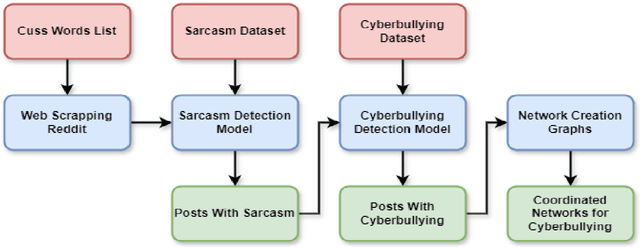Kashish Gandhi
Cyberbullying or just Sarcasm? Unmasking Coordinated Networks on Reddit
Oct 26, 2024


Abstract:With the rapid growth of social media usage, a common trend has emerged where users often make sarcastic comments on posts. While sarcasm can sometimes be harmless, it can blur the line with cyberbullying, especially when used in negative or harmful contexts. This growing issue has been exacerbated by the anonymity and vast reach of the internet, making cyberbullying a significant concern on platforms like Reddit. Our research focuses on distinguishing cyberbullying from sarcasm, particularly where online language nuances make it difficult to discern harmful intent. This study proposes a framework using natural language processing (NLP) and machine learning to differentiate between the two, addressing the limitations of traditional sentiment analysis in detecting nuanced behaviors. By analyzing a custom dataset scraped from Reddit, we achieved a 95.15% accuracy in distinguishing harmful content from sarcasm. Our findings also reveal that teenagers and minority groups are particularly vulnerable to cyberbullying. Additionally, our research uncovers coordinated graphs of groups involved in cyberbullying, identifying common patterns in their behavior. This research contributes to improving detection capabilities for safer online communities.
Infectious Disease Forecasting in India using LLM's and Deep Learning
Oct 26, 2024Abstract:Many uncontrollable disease outbreaks of the past exposed several vulnerabilities in the healthcare systems worldwide. While advancements in technology assisted in the rapid creation of the vaccinations, there needs to be a pressing focus on the prevention and prediction of such massive outbreaks. Early detection and intervention of an outbreak can drastically reduce its impact on public health while also making the healthcare system more resilient. The complexity of disease transmission dynamics, influence of various directly and indirectly related factors and limitations of traditional approaches are the main bottlenecks in taking preventive actions. Specifically, this paper implements deep learning algorithms and LLM's to predict the severity of infectious disease outbreaks. Utilizing the historic data of several diseases that have spread in India and the climatic data spanning the past decade, the insights from our research aim to assist in creating a robust predictive system for any outbreaks in the future.
A Multimodal Framework for Deepfake Detection
Oct 04, 2024Abstract:The rapid advancement of deepfake technology poses a significant threat to digital media integrity. Deepfakes, synthetic media created using AI, can convincingly alter videos and audio to misrepresent reality. This creates risks of misinformation, fraud, and severe implications for personal privacy and security. Our research addresses the critical issue of deepfakes through an innovative multimodal approach, targeting both visual and auditory elements. This comprehensive strategy recognizes that human perception integrates multiple sensory inputs, particularly visual and auditory information, to form a complete understanding of media content. For visual analysis, a model that employs advanced feature extraction techniques was developed, extracting nine distinct facial characteristics and then applying various machine learning and deep learning models. For auditory analysis, our model leverages mel-spectrogram analysis for feature extraction and then applies various machine learning and deep learningmodels. To achieve a combined analysis, real and deepfake audio in the original dataset were swapped for testing purposes and ensured balanced samples. Using our proposed models for video and audio classification i.e. Artificial Neural Network and VGG19, the overall sample is classified as deepfake if either component is identified as such. Our multimodal framework combines visual and auditory analyses, yielding an accuracy of 94%.
* 22 pages, 14 figures, Accepted in Journal of Electrical Systems
Predicting Solar Energy Generation with Machine Learning based on AQI and Weather Features
Aug 22, 2024



Abstract:This paper addresses the pressing need for an accurate solar energy prediction model, which is crucial for efficient grid integration. We explore the influence of the Air Quality Index and weather features on solar energy generation, employing advanced Machine Learning and Deep Learning techniques. Our methodology uses time series modeling and makes novel use of power transform normalization and zero-inflated modeling. Various Machine Learning algorithms and Conv2D Long Short-Term Memory model based Deep Learning models are applied to these transformations for precise predictions. Results underscore the effectiveness of our approach, demonstrating enhanced prediction accuracy with Air Quality Index and weather features. We achieved a 0.9691 $R^2$ Score, 0.18 MAE, 0.10 RMSE with Conv2D Long Short-Term Memory model, showcasing the power transform technique's innovation in enhancing time series forecasting for solar energy generation. Such results help our research contribute valuable insights to the synergy between Air Quality Index, weather features, and Deep Learning techniques for solar energy prediction.
 Add to Chrome
Add to Chrome Add to Firefox
Add to Firefox Add to Edge
Add to Edge